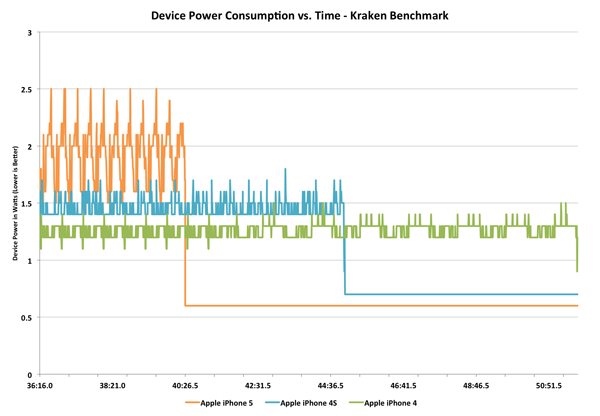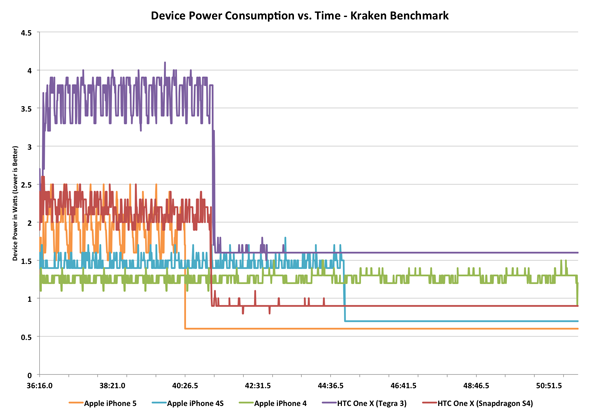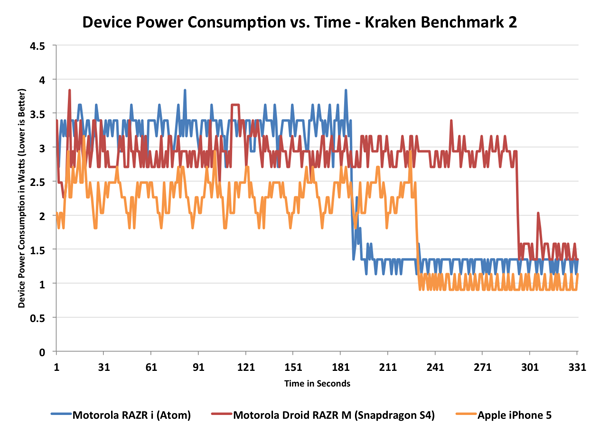The iPhone 5 Review
by Anand Lal Shimpi, Brian Klug & Vivek Gowri on October 16, 2012 11:33 AM EST- Posted in
- Smartphones
- Apple
- Mobile
- iPhone 5
Increased Dynamic Range: Understanding the Power Profile of Modern SoCs
Section by Anand Shimpi
The iPhone 4S greatly complicated the matter of smartphone power consumption. With the A5 SoC Apple introduced a much wider dynamic range of power consumption to the iPhone than we were previously used to. Depending on the workload, the A5 SoC could either use much more power than its predecessor or enjoy decreased overall energy usage. I began our battery life analysis last time with some graphs showing the power savings realized by a more power hungry, faster CPU.
The iPhone 5 doesn't simplify things any more. I believe the days of us having straightforward discussions about better/worse battery life are long gone. We are now firmly in the era of expanded dynamic range when it comes to smartphone power consumption. What do I mean by that? The best way to explain is to look at some data. The graphs below show total device power consumption over time for a handful of devices running the Mozilla Kraken javascript benchmark. Kraken is multithreaded and hits the CPU cores fairly well. The power profile of the benchmark ends up being very similar to loading a very js-heavy web page, although for a longer period of time. All of the device displays were calibrated to 200 nits, although obviously larger displays can consume more power.
Let's start out by just looking at the three most recent iPhone generations:
The timescale for this chart is just how long the iPhone 4 takes to complete the Kraken benchmark. The iPhone 4/4S performance gap feels a lot bigger now going back to the 4 than it did when the 4S launched, but that's how it usually seems to work. Note how tight the swings are between min and max power consumption on the iPhone 4 during the test. As a standalone device you might view the iPhone 4 as being fairly variable when it comes to power consumption but compared to the 4S and 5 it might as well be a straight line.
The 4S complicated things by consuming tangibly more power under load than the 4, but being fast enough to complete tasks in appreciably less time. In the case of this Kraken run, the 4S consumes more power than the 4, however it's able to go to sleep quicker than the 4 and thus draw less power. If we extended the timeline for the iPhone 4 significantly beyond the end of its benchmark run we'd see the 4S eventually come out ahead in battery life as it was able to race to sleep quicker. The reality is that with more performance comes increased device usage - in other words, it's highly unlikely that with a 50% gain in performance users are simply going to continue to use their smartphone the same way as they would a slower device. Usage (and thus workload) doesn't remain constant, it's somewhat related to response time.
The iPhone 5 brings new meaning to device level power consumption. With a larger display and much more powerful CPU, it can easily draw 33% more power than the 4S under load, on average. Note the big swings in power consumption during the test. The A6 SoC appears to be more aggressive in transitioning down to idle states than any previous Apple SoC, which makes sense given how much higher its peak power consumption can be. Looking at total energy consumed however, the iPhone 5 clearly has the ability to be more power efficient on battery. The 5 drops down to iPhone 4 levels of idle power consumption in roughly half the time of the iPhone 4S. Given the same workload that doesn't run indefinitely (or nearly indefinitely), the iPhone 5 will outlast the iPhone 4S on a single charge. Keep the device pegged however and it will die quicker.
Out of curiosity I wanted to toss in a couple of other devices based on NVIDIA and Qualcomm silicon to see how things change. I grabbed both versions of the HTC One X:
The Tegra 3 based One X actually performs very well in this test, but its peak power consumption is significantly worse than everything else. It makes sense given the many ARM Cortex A9 cores built on a 40nm G process running at high clock speeds on the Tegra 3.
The 28nm Snapdragon S4 (dual-core Krait) based One X gives us some very interesting results. Peak power consumption looks identical to the iPhone 5, however Apple is able to go into deeper sleep states than HTC can with its S4 platform. Performance is a little worse here but that could be a combination of SoC and software/browser. I used Chrome for all of the tests so it should be putting Android's best foot forward, but the latest update to Safari in iOS 6 really did boost javascript performance to almost untouchable levels.
At the end of the day, the power profile of the iPhone 5 appears to be very close to that of a modern Snapdragon S4 based Android smartphone. Any battery life gains that Apple sees are strictly as a result of software optimizations that lead to better performance or the ability to push aggressively to lower idle power states (or both). It shouldn't be very surprising that these sound like a lot of the same advantages Apple has when talking about Mac battery life as well. Don't let the CPU cores go to sleep and Apple behaves similarly to other device vendors, but it's really in idle time or periods of lighter usage that Apple is able to make up a lot of ground.
There's one member of the modern mobile SoC market that we haven't looked at thus far: Intel's Medfield. The data below isn't directly comparable to the data above, my measurement methods were a little different but the idea is similar - we're looking at device level power consumption over time while Kraken runs. Here I'm only focusing on the latest and greatest, the Atom based Motorola RAZR i, the Snapdragon S4 based Droid RAZR M and the iPhone 5. The RAZR i/M are nearly identical devices making this the perfect power profile comparison of Atom vs. Snapdragon S4. The RAZR i is also the first Atom Z2460 based part to turbo up to 2.0GHz.
Very interesting. Atom is the only CPU that can complete the Kraken benchmark in less time than Apple's Swift. Peak power consumption is definitely higher than both the Qualcomm and Apple devices, although Intel's philosophy is likely that the added power usage is worth it given the quicker transition to idle. Note that Atom is able to drive to a slightly lower idle level than the Snapdragon S4, although the Swift based iPhone 5 can still go lower.
At least based on this data, it looks like Intel is the closest to offering a real competitor to Apple's own platform from a power efficiency standpoint. We're a couple quarters away from seeing the next generation of mobile SoCs so anything can happen next round, but I can't stress enough that the x86 power myth has been busted at this point.
I will add that despite Intel's performance advantage here, I'm not sure it justifies the additional peak power consumption. The RAZR i ends up being faster than the iPhone 5 but it draws substantially more power in doing so, and the time savings may not necessarily offset that. We'll see what happens when we get to our battery life tests.













276 Comments
View All Comments
darwinosx - Tuesday, October 16, 2012 - link
The iPhone 5 display is better than any current Android display.But Motorola and Android if you want a company that is dying and being sold and a copycat cheap phone with no service and support.
V-Money - Tuesday, October 16, 2012 - link
Your wisdom and informative argument adds tremendous value to this post. For the record though, the OP said specifically battery life and 720p display, so the response was relevant.The rest of your post is petty, get over yourself. If you are going to play the copycat card you should have done it before Apple decided to go with a bigger screen and use a (eerily similar) notification bar to what Android phones have had for years.
As for quality (of display or otherwise), that is subjective analysis and considering that Apple only releases one phone at a time and Android manufacturers many, its a stupid argument for anyone to make. Case and point, I can find many android phones that are much more terrible than the iPhone, but I can also find many that are better. The iPhone is a decent phone, but its not for everyone. Every consumer has their preference.
My point being there is not one-size-fits-all phone, so quit acting high and mighty with your close mindedness. You are not better than those around you because you bought into Apple's marketing, you are just a fool dealing with the first world problem of living such a meaningless existence that you have to hold on to the imaginary power an inanimate object pretends to give to you.
Alucard291 - Tuesday, October 16, 2012 - link
I feel that your argument may be too good for him to reply to :)He seems awfully angry :D
crankerchick - Tuesday, October 16, 2012 - link
Great reply. If there's one place I just want to exchange comments without playing the "my toy is better than yours" game, it's here on AnandTech.Gradly - Wednesday, October 17, 2012 - link
I'm sick of ppl comparing iPhone to other devices. I'm sick of those telling you iPhone borrowed the notifications slider form android and skipping the myriad of things that other borrowed form iPhone. Apple has always said that "we are not the first but we do it the best". I'm sick of those who still don't realize that before iPhone ppl were living in caves actually.I'm an Apple lover not an Apple fanboy. I just adore the design, aesthetics, and GUI of Apple devices.
Penti - Wednesday, October 17, 2012 - link
It's sadly Apple that goes and patent UI-elements to use against their competitors that is why it's always brought up. It would be totally unnecessary otherwise. You might look at who's the inspiration otherwise and it's often not Apple. In reality we had capacitive touch screens (it's not Apples tech of course) before, app store before, Android even had an SDK out before Apple. Competitors like Symbian/Nokia, HP WebOS, and Blackberry are even allowed to use stuff like bounce back effect even without (or before) any agreement with Apple. They should have credit but they didn't all the sudden bring out their device with what we now call smartphone features, it lacked most functions at first and slowly iterated, it did a lot poorer in many areas then it's competitors was doing even before iPhone and the first few years it also showed in sales numbers which were not high at the first 2-3 years. It did show us how important a good platform was. Guys like Rubin had already figured that out though. So I'm not sure what they would borrow. Full WebKit-browsers on mobile is a good example of stuff they are co-developing but it was out in Nokia devices in 2006, netfront and Opera was never good alternatives to build into your platform. Stock Android don't have the bounce back effect, UI's looking like Apples and so on. Not even TouchWiz on Samsung's tablets looks like or infringes anything (design-wise) by Apple. They clearly have their own ideas. They are not the "me too", others might try to emulate them more in a business sense though. But they will be punished by the market by their execution instead of by Apple. It's not like any of the major players are fruit ninja-clones though.iPhone was desperately rudimentary at first. It didn't do applications and the web, messaging, photos etc better then anybody. What they did good was to iterate and improve. They take enterprise / corporate customers more seriously then Microsoft and so on in this field. Even if it took some time for them to get there. So they do plenty of good. It's a good platform, but it's not like they gave their competitors their blueprints for their devices / os of today back in 2007 and both have made many improvements. Well maybe not Microsoft but it takes a few years to start over. Apple has even got into hardware (components) a bit. Commoditization and convergence has reached far beyond the mobile field. That's great even if Apple won't enter them. Still don't know why any competitor would like to turn themselves into a retail giant and employ mostly store staff as Apple does – Microsoft should start doing what they are good at instead. Google would be the most evil company in the world if they had started to patent and sue based on UI-features and methods. Or if they really tried to stop Bing and Bing Maps (and getting it banned in some markets) for example. It doesn't really matter who was first and who invented what if you take it to court were that doesn't really count and that creates a lot of BS surrounding the whole issue and companies involved that is largely unnecessary. But the real silly thing is why they fight. It's not based on IPR, it's basically that they want to be alone in doing whatever, even if they can't really make that claim to have sole rights to something. But ultimately courts do get that under control even when corporate leaders turn to fighting outside of releasing product.
slickr - Tuesday, October 16, 2012 - link
LOL. Don't make me laugh. It has still the worst display and has had the worst display for at least 3 years.A5 - Tuesday, October 16, 2012 - link
Your response is just as dumb as his. The iPhones have excellent displays.medi01 - Wednesday, October 17, 2012 - link
None of the iPhones have anything to compare with AMOLEDs, on top of having idiotic resolution.On tablet space, only iPad 3 matched color gamut of THE FIRST Samsung Galaxy Tab.
thunng8 - Wednesday, October 17, 2012 - link
How does 67.5% of sRGB on the galaxy tab 10.1 match the 94.4% on the ipad 3?http://www.anandtech.com/show/5688/apple-ipad-2012...